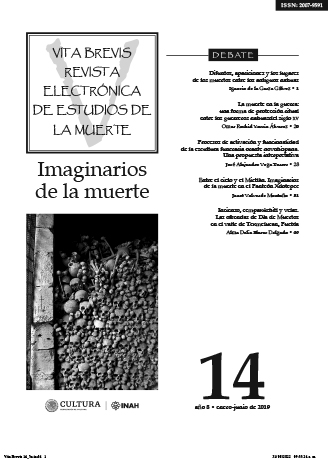La muerte en la guerra: una forma de protección ritual entre los guerreros nahuas del siglo XV
Keywords:
Ritual, Warriors, Death, Worldview, CodicesAbstract
Death is a complicated process, which has a series of sociocultural implications, with a form of mythicalritual expression in the great diversity of human groups, that are capable of being analyzed from symbolic anthropology and ethnohistory, among other disciplines. Thus, ritual is considered an expression of traditional knowledge, the implementation of magical and religious knowledge, therefore, this work aims to present an example of a protection ritual performed by the 15th century Nahuas warriors, located in sheet 18 of the FejérváryMayer codex. The method of analysis is Galarza, since it allows a glyphic interpretation at different levels, which lead to establishing a paradigm of the composition of the sheet, global reading. This reading will be compared with the analyzes of Doctors Jansen, Anders and Reyes García, in addition to Dr. Miguel LeónPortilla, highlighting the common elements to emphasize their own observations. In this way, the analyzed ritual can be placed in a specific place, in the great and complex framework of the Nahua worldview.
Downloads
References
ACOSTA, José de, Historia natural y moral de las indias, México, FCE, 1940.
ANDERS, Ferdinand, Maarten JANSEN y Luis Reyes GARCÍA, El Libro de Tezcatlipoca, señor del tiempo. Libro explicativo del Códice Fejérváry-Mayer, México, FCE, 1994.
GEERTZ, Clifford, La interpretación de las culturas, Gedisa, España, 2006.
JOHANSSON, Patrick, “Las trecenas del tonalpohualli y las veintenas del cempoallapohualli en el Códice Mexicanus”, Estudios de Cultura Náhuatl, núm. 58, julio-diciembre de 2019.
LEÓN-PORTILLA, Miguel, “El Tonalámatl de los pochtecas (Códice FejérváryMayer)”, Arqueología Mexicana, núm. 18, 2003.
LLAMAZARES, Ana María y Carlos MARTÍNEZ SARASOLA, “Reflejos de la cosmovisión originaria. Arte indígena y chamanismo en el Noroeste argentino”, en M. Goretti (ed.), Tesoros precolombinos del Noroeste argentino, Buenos Aires, Fundación CEPPA, 2006, pp. 6391.
MOHAR, Luz Ma. y Rita FeRnández díAz, “Introducción y comentario. El estudio de los códices”, Desacatos. Revista de Ciencias Sociales, núm. 22, septiembre-diciembre de 2006, pp. 936.
MORIN, Edgar, El hombre y la muerte, Kairos, Barcelona, 1974.
OLKO, Justyna, “Traje y atributos de poder en el mundo azteca: significados y funciones contextuales”, Anales del Museo de América, núm. 14, 2006, pp. 6188.
OSEGUERA, Andrés, “De ritos y antropólogos. Perspectivas teóricas sobre el ritual indígena en la antropología realizada en México”, Cuicuilco, vol. 15, núm. 42, enero-abril de 2008, pp. 97118.
RESTREPO A., Roberto, “Cosmovisión, pensamiento y cultura”, Revista Universidad EAFIT, vol. 34, núm. 111, julio-septiembre de 1998, pp. 3342.
YASSIN ÁLVAREZ, Omar Rashid, “Análisis iconográfico de las representaciones del dios de la muerte en el Códice Borgia”, tesis de licenciatura, UAEH (Biblioteca Digital), Pachuca, 2015.
Downloads
Published
How to Cite
Issue
Section
License
Copyright (c) 2019 Instituto Nacional de Antropología e Historia

This work is licensed under a Creative Commons Attribution 4.0 International License.



